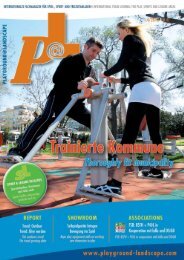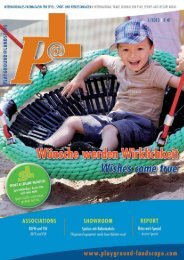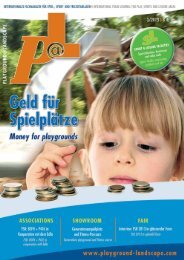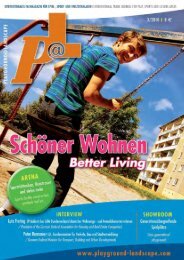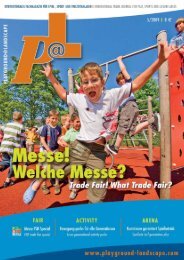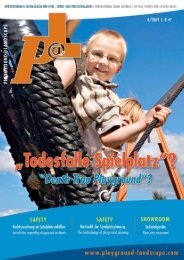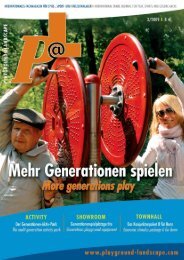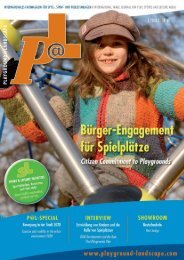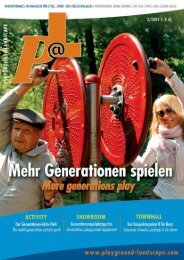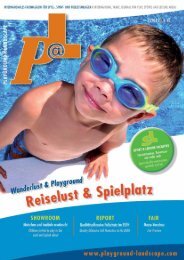Download - Playground@Landscape
Download - Playground@Landscape
Download - Playground@Landscape
Sie wollen auch ein ePaper? Erhöhen Sie die Reichweite Ihrer Titel.
YUMPU macht aus Druck-PDFs automatisch weboptimierte ePaper, die Google liebt.
Foto: Fotolia / © Daniel Etzold<br />
Auf Basis dieser Kategorisierung zeigt sich deutlich, dass die<br />
Befragten mit einem Anteil von 70,6% der Stichprobe die<br />
Bedeutung Bewegung als „Medium zur Entwicklungsförderung“<br />
priorisieren 4 . Den geringsten Stellenwert nimmt das<br />
Bedeutungsfeld „Bewegung als Medium des Lernens“ ein<br />
(18,2 %).<br />
Die Ergebnisse zeigen zudem, dass die Untersuchungsteilnehmerinnen<br />
größtenteils Antwortmöglichkeiten<br />
zu allen vier Bedeutungsfeldern ankreuzen.<br />
Dies kann als Anhaltspunkt dafür gesehen<br />
werden, dass bei den Fachkräften kein einseitiges,<br />
sondern ein relativ komplexes Verständnis zum<br />
Thema Bewegung bei Kindern im Alter von 0-6<br />
Jahren vorherrscht. Zudem wird deutlich, dass<br />
die „Negativ-Assoziationen“ nur sehr selten angekreuzt<br />
wurden (vgl. Stahl-von Zabern u.a.,<br />
2013 i.Dr.).<br />
Bewegungsbezogene<br />
Ausbildungsschwerpunkte und<br />
Fortbildungswünsche<br />
Die Ergebnisse sprechen für eine mehrheitlich<br />
positive Bewertung (hoch bzw. sehr hoch) der Bedeutung<br />
von Bewegung für die gesamte Entwicklung<br />
und die förderliche Wirkung auf Gesundheit<br />
und Bildung von Kindern im Alter von 0 – 6 Jahren<br />
von Seiten der Fachkräfte. Um den Bildungsbereich<br />
Bewegung im Kita-Alltag adäquat umzusetzen, ist<br />
neben struktureller Rahmenbedingungen (Personalschlüssel,<br />
Raum-, Materialangebot etc.) auch eine breite<br />
Wissensbasis der Fachkraft eine Voraussetzung. Hierzu stellt<br />
sich die Frage nach der angemessenen fachspezifischen Ausbildung<br />
der frühpädagogischen Fachkräfte. Anhand einer<br />
the fundamental<br />
approach of<br />
each text and document.<br />
Coloured highlighting of text passages<br />
made it possible to prepare profiles of the<br />
various preschool education guidelines and to compare these systematically<br />
with each other 2 .In all the curricula and guidelines issued by the<br />
states in the years 2004 – 2011, exercise is treated as a separate subject.<br />
The terminology most commonly used as a designation for the subject<br />
is “Body, exercise, health”. When it comes to the purpose of teaching<br />
children this subject, the objective of “Exercise to promote development”<br />
is significantly preferred over that of health education as such or the concepts<br />
of exercise and physicality. The strategy of linking exercise and performance<br />
capacity with other aspects of education (exercise as a means<br />
of learning) is rarely accounted for. Those responsible for drawing up<br />
guidelines seem to consider exercise and physical movement to be essentially<br />
little more than a means to an end; the establishment of a wide<br />
ranging programme of exercises is not their primary objective.<br />
The role of exercise from the point of<br />
view of early childhood educators<br />
Selected findings of the survey conducted as part of the BiK project 1,3 are<br />
cited in the following in order to illustrate this aspect as it applies to the<br />
preschool educational sector. The purpose of the empirical study was to<br />
undertake a detailed analysis of the actual status of the implementation<br />
of and the relevance accorded to exercise strategies at child day care<br />
centres and of the extent to which early childhood educators receive training<br />
or continued training in this subject. The results obtained during the<br />
project were used to redefine specifications for training courses and further<br />
education programmes in this area. Data was collected by means of<br />
an online survey of early childhood educators conducted in 2012. The<br />
total of 2400 responders can be said to be a representative sample of those<br />
educators working in the various states and for the various support organisations.<br />
The survey responders were asked about what they associated<br />
with the topic of exercise in the case of children in the age range<br />
0 – 6 years. The four categories were listed, and a significant percentage<br />
(70.6%) assigned priority to the concept of exercise as a “Means of<br />
promoting development”4. The category that was assigned the least<br />
importance was “Exercise as a means of learning” (18.2%). The results<br />
also demonstrated that the majority of survey participants tended to<br />
select possible responses to all four options. This can be seen as an<br />
indication that educators do not have a standardised but relatively complex<br />
view of the role of exercise in children aged 0 – 6 years. Another<br />
significant finding was the fact that “negative associations” were only<br />
68



